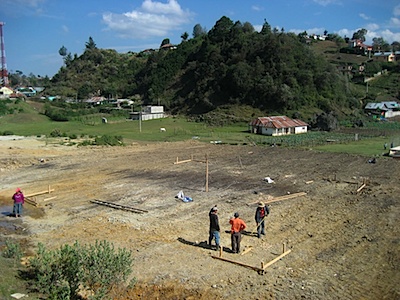This week began the construction of the Rafael Juárez teachers’ school. I guess we’re really going to build this thing! I hope to post regular updates as the work progresses, so you can see how a larger structure gets built in Guatemala. If I do a good job as reporter, maybe it will even be interesting to people besides my architect and contractor buddies.
The site was leveled last week with three days of bulldozer work the Mayor donated to the cause. Everyone was excited about that, as they were expecting to have to do it with a month of 50 guys with hoes. Whew! Besides the head mason Pascual, there are about 6 other masons that are directing the work. Right now as we lay out the building, it’s kindof a “too many cooks” situation, but in a few weeks when we have 50 people running around at once with hoes and shovels and block, it will be a huge help. The #2 guy, León, is solid and asks a lot of good questions. He quickly and decisively got the main lines of the building set up and squared.
One of our first concerns was locating the building on the site. There aren’t zoning regulations or site setbacks in 99% of Guatemala, but we don’t want to be so close to the road that it inhibits traffic flow or pedestrians entering the building. We also don’t want to be too close to the neighbors on either side, so as to cause conflict with views or ventilation. After some discussion, the building committee decided that the setback would be 3 meters… a number I agreed with.
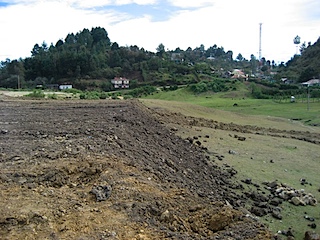 In order to make a flat place for the building, a fair amount of earth had been cut. This is good; the 2nd-floor entry should (more or less) match up with the road level. The fill was then moved to the south of the site to enlarge the flat area, and compacted by rolling the bulldozer back and forth over it a bunch of times. This is somewhat of a concern to me, because compacted earth is never as stable as cut earth… leaving the possibility of differential settling. In this US, this would demand fancy-pants things like nuclear density testing, or at least a modified Proctor (1). But in Guatemala? It should be OK: the structure isn’t very heavy, it is separated in to zones that wouldn’t be damaged if they settled separately, and a little superficial nonstructural cracking doesn’t raise eyebrows here. My only remaining concern is that the edge of the fill dirt pad has a really steep angle of repose. The soil here has a high clay content, but I don’t trust that slope, so I set the building as far away from it as I could to avoid any chance of erosion and/or collapse.
In order to make a flat place for the building, a fair amount of earth had been cut. This is good; the 2nd-floor entry should (more or less) match up with the road level. The fill was then moved to the south of the site to enlarge the flat area, and compacted by rolling the bulldozer back and forth over it a bunch of times. This is somewhat of a concern to me, because compacted earth is never as stable as cut earth… leaving the possibility of differential settling. In this US, this would demand fancy-pants things like nuclear density testing, or at least a modified Proctor (1). But in Guatemala? It should be OK: the structure isn’t very heavy, it is separated in to zones that wouldn’t be damaged if they settled separately, and a little superficial nonstructural cracking doesn’t raise eyebrows here. My only remaining concern is that the edge of the fill dirt pad has a really steep angle of repose. The soil here has a high clay content, but I don’t trust that slope, so I set the building as far away from it as I could to avoid any chance of erosion and/or collapse.
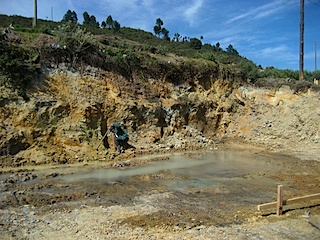 Here is an area of the site towards the north property line. Apparently there is a natural spring here, and it reminds me of an architectural nightmare I saw about fifteen years ago, where a building (Jerry calls it “the Titanic”) was unknowingly built on a seasonal artesian flow. The following springtime, the water came and flooded the entire basement, costing the owner (and architect and contractor) a lot of money and time to remedy. Pascual and I are both concerned about it, and we’re going to put in a drain to take the water to the bottom of the site, where the women gather anyways to wash their clothes in the stream. I am sure they will be pleased. As we were talking about it, we also decided that we are going to build the floor slabs the American way, with 6 mil poly sheeting and 10cm of gravel to keep the slab from wicking ground moisture. Pascual had used the technology once before, and was pretty excited that I want to build it this way as well. Many Guatemalan buildings are perpetually damp from concrete floors directly on the soil, combined with those annoying flat concrete roofs. This school will not be.
Here is an area of the site towards the north property line. Apparently there is a natural spring here, and it reminds me of an architectural nightmare I saw about fifteen years ago, where a building (Jerry calls it “the Titanic”) was unknowingly built on a seasonal artesian flow. The following springtime, the water came and flooded the entire basement, costing the owner (and architect and contractor) a lot of money and time to remedy. Pascual and I are both concerned about it, and we’re going to put in a drain to take the water to the bottom of the site, where the women gather anyways to wash their clothes in the stream. I am sure they will be pleased. As we were talking about it, we also decided that we are going to build the floor slabs the American way, with 6 mil poly sheeting and 10cm of gravel to keep the slab from wicking ground moisture. Pascual had used the technology once before, and was pretty excited that I want to build it this way as well. Many Guatemalan buildings are perpetually damp from concrete floors directly on the soil, combined with those annoying flat concrete roofs. This school will not be.
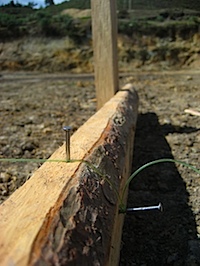 Most construction techniques are thousands of years old, and remain in use even in the US. For example, foundations are laid out with string attached to puentes (batter boards) so they can be excavated while maintaining a true line. But I learn a new trick every time I visit a jobsite; in this case, the line is set with TWO nails, one to hold the knot, and another to get the string really exact. The measuring point is at the side of the nail, so the width of the nail doesn’t induce an error in your measurement. Nice. Builders here also borrow tricks from the classical Greeks, such as the 3-4-5 triangle to find right angles, and matching diagonals to form a perfect square.
Most construction techniques are thousands of years old, and remain in use even in the US. For example, foundations are laid out with string attached to puentes (batter boards) so they can be excavated while maintaining a true line. But I learn a new trick every time I visit a jobsite; in this case, the line is set with TWO nails, one to hold the knot, and another to get the string really exact. The measuring point is at the side of the nail, so the width of the nail doesn’t induce an error in your measurement. Nice. Builders here also borrow tricks from the classical Greeks, such as the 3-4-5 triangle to find right angles, and matching diagonals to form a perfect square.
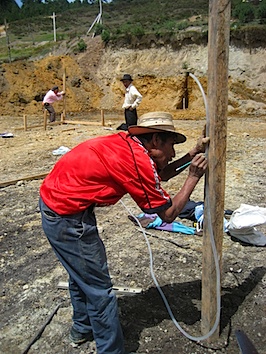
But some things are different from the US. American contractors nowadays use a revolving laser level to make everything the same height. The masons here use a technology that the Egyptians used to build the pyramids: the water level. A body of water seeks the same level regardless of its container. If you fill a hose with water, the water level at both ends will be identical. Here we see the mason locating the top of the floor slab height at the corner, using a central reference. The “Mayan Laser” is nothing more than a clear hose.
While we were laying out the building, we talked about foundation construction. It’s typical in Guatemala to throw giant rocks into the foundations to save on concrete. I explained that we were just going to use concrete only, so I could be sure there are no voids and that the structure will meet the calculations I’ve made. Spending a little extra on concrete is worth it for that security. I also explained that they need to agitate the concrete to get it to settle properly. “¿Con vibradór?” León asked. Wow, this guy is on it! He’s the first Guatemalan I’ve ever met that has heard of vibrating concrete. Things are definitely looking up.
As I left the site today, I explained that I will only be able to come by occasionally, since I have a lot of other stuff I’m doing, but they can call me whenever they have a question or need clarification. I feel pretty confident they will do just fine. But I DID make it clear that I want to inspect all trenches, footings, and rebar arrangements before any day that they are going to pour concrete. Those things are impossible to inspect after the fact (with the equipment at hand, anyways) and if done wrong will set up a hidden weakness that could prove disastrous down the road.
As an aside, I also learned my first “dirty word” in Q’anjob’al at the construction site. How’s THAT for reinforcing a stereotype? It’s crazy that I had to be here for more than a year and half to learn one; I guess that demonstrates how conservative the culture here is.
(1) Beware the Full Proctor! 😉
